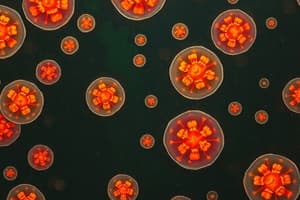Podcast
Questions and Answers
What are the structural differences between MHC class I and MHC class II molecules?
What are the structural differences between MHC class I and MHC class II molecules?
MHC Class I is composed of α₁, α₂, α₃, and β₂, binds to CD8, and α₁ and α₂ form the peptide binding grove. MHC Class II is composed of α₁, α₂, β₁, and β₂, binds to CD4 at β₂, and α₁ and β₁ form the peptide binding grove.
On which MHC molecule are exogenous and endogenous antigens presented?
On which MHC molecule are exogenous and endogenous antigens presented?
Endogenous antigens are presented in the context of MHC class I while exogenous antigens are presented in MHC class II.
Which cells express MHC class I molecules?
Which cells express MHC class I molecules?
All nucleated cells and platelets express MHC class I.
Which cells express MHC class II molecules?
Which cells express MHC class II molecules?
How are MHC alleles expressed and inherited?
How are MHC alleles expressed and inherited?
How do polymorphisms and polygeny contribute to the diversity of MHC molecules expressed by an individual?
How do polymorphisms and polygeny contribute to the diversity of MHC molecules expressed by an individual?
Describe the advantage of MHC heterozygosity.
Describe the advantage of MHC heterozygosity.
What role do MHC molecules play in transplant rejection?
What role do MHC molecules play in transplant rejection?
What is the function of the MHC?
What is the function of the MHC?
What are TAP1 and TAP2?
What are TAP1 and TAP2?
How are cytotoxic CD8 T cell responses generated in response to a viral infection?
How are cytotoxic CD8 T cell responses generated in response to a viral infection?
What is cross presentation?
What is cross presentation?
How are CD8 responses generated if the virus does not directly infect an antigen-presenting cell?
How are CD8 responses generated if the virus does not directly infect an antigen-presenting cell?
What prevents peptides in the ER from binding to the MHC class II molecule?
What prevents peptides in the ER from binding to the MHC class II molecule?
What is the function of the invariant chain molecule?
What is the function of the invariant chain molecule?
Define MHC Class I deficiency.
Define MHC Class I deficiency.
Define MHC class II deficiency.
Define MHC class II deficiency.
What is HLA?
What is HLA?
What is polymorphism?
What is polymorphism?
What are alleles?
What are alleles?
What is a haplotype?
What is a haplotype?
What are the most polymorphic MHC Class I isotypes?
What are the most polymorphic MHC Class I isotypes?
What are the most polymorphic MHC Class II isotypes?
What are the most polymorphic MHC Class II isotypes?
What is the difference between graft versus host disease and transplant rejection?
What is the difference between graft versus host disease and transplant rejection?
Flashcards are hidden until you start studying
Study Notes
Structural Differences Between MHC Class I and Class II
- MHC Class I consists of α₁, α₂, α₃, and β₂ subunits.
- MHC Class II contains α₁, α₂, β₁, and β₂ subunits.
- MHC Class I binds CD8, while MHC Class II binds CD4 at the β₂ subunit.
- Peptide binding grooves are formed by α₁ and α₂ in Class I, and α₁ and β₁ in Class II.
Antigen Presentation
- Endogenous antigens, from within the cell, are presented via MHC Class I after loading peptides in the ER.
- Exogenous antigens enter externally and are presented via MHC Class II after being processed in acidified endocytic vesicles.
Expression of MHC Molecules
- All nucleated cells and platelets express MHC Class I.
- MHC Class II is predominantly found on antigen-presenting cells (APCs), including dendritic cells, B cells, and macrophages.
- Activated T cells and thymic epithelium can also express MHC Class II.
Inheritance and Diversity of MHC Alleles
- HLA genes are co-dominantly expressed, one haplotype inherited from each parent.
- Variation in MHC allotypes is notably concentrated at peptide and TCR binding sites, enhancing diversity.
Advantages of MHC Heterozygosity
- Heterozygosity significantly increases the ability to recognize a broader range of peptides.
MHC in Transplant Rejection
- Matching MHC Class I and II is crucial for transplants to minimize rejection, as a strong T cell response occurs against "foreign" MHC molecules.
MHC Function and Transport
- The primary function of MHC molecules is to present antigens to T cells.
- TAP1 and TAP2 genes are responsible for transporting peptides into the ER for MHC Class I loading.
Cytotoxic T Cell Responses
- Cytotoxic CD8 T cell responses are triggered when viral antigens, presented by MHC Class I molecules, are recognized.
- Cross-presentation allows extracellular antigens to be presented on MHC Class I, important for vaccine design.
Mechanisms Preventing Inappropriate Binding
- The invariant chain prevents premature binding of peptides to MHC Class II until reaching endocytic vesicles.
- HLA-DM facilitates the release of the CLIP fragment, allowing peptide binding.
MHC Deficiencies
- MHC Class I deficiency leads to severely reduced CD8 T cells, increasing vulnerability to respiratory viral infections.
- MHC Class II deficiency, or Bare Lymphocyte syndrome, results in increased susceptibility to pathogens and deficient CD4 T cell counts, often manifesting as severe combined immunodeficiency (SCID).
Polymorphism and Alleles
- Polymorphism refers to the presence of multiple gene variants, enhancing genetic diversity.
- Alleles are different forms of a gene at a single locus.
Haplotype Overview
- A haplotype denotes a set of polymorphic genes on one chromosome, with humans having two inherited haplotypes.
Most Polymorphic MHC Isotypes
- MHC Class I: HLA-A, HLA-B, HLA-C.
- MHC Class II: HLA-DP, HLA-DQ, HLA-DR.
Graft Versus Host Disease vs. Transplant Rejection
- In kidney transplants, recipient T cells attack the transplanted kidney.
- In bone marrow transplants, T cells from the transplant attack the recipient's tissues.
Studying That Suits You
Use AI to generate personalized quizzes and flashcards to suit your learning preferences.




